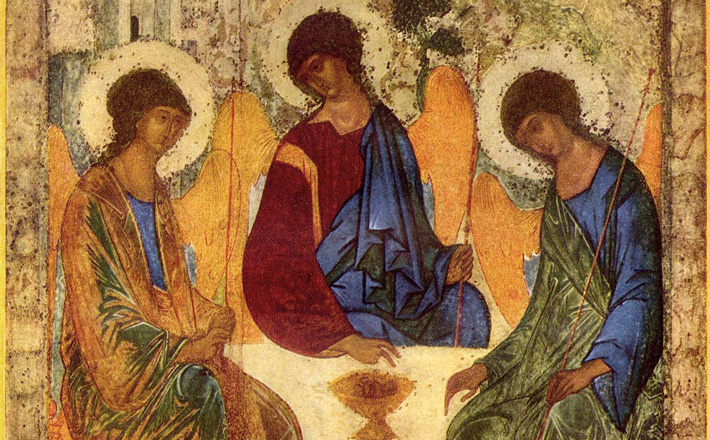Commentary on Matthew 28:16-20
What does the Great Commission have to do with the Trinity?
Readers today often interpret this passage as a directive to evangelize others. After all, the imperative verb is right there: “make disciples of all nations…” (28:19). Although Jesus uses the formula “Father and Son and Holy Spirit,” Trinitarian theology as we know it took many centuries to develop. Reading it backward into this first century Gospel may not be appropriate.
But if we only read this passage as a manifesto on evangelism, we may be missing out. The passage is also a strong statement of the authority of the risen Jesus. The word “therefore” in “Go therefore and make disciples” suggests that the action of making disciples results from the previous verse: “All authority in heaven and on earth has been given to me” (Matthew 20:18). Jesus’ instructions result from the authority he possesses.
Because of this, it is fitting to reflect on this passage on Holy Trinity Sunday. The risen Jesus, fully vested with divine authority, stands before his disciples with one final teaching. Preachers may want to create an experience in which listeners, like the eleven, contemplate Jesus in his risen form as the Son to whom all authority is given.
“All authority in heaven and on earth has been given to me” (Matthew 28:18). Jesus’ authority has been apparent from the outset of the Gospel. His healing powers testify to his authority over demons and sickness. He casts out demons “by the Spirit of God,” which is evidence of the presence of God’s kingdom (12:28). The power of God’s Spirit comes into the world through Jesus as he shows compassion to those who need him (9:36; 14:14).
Jesus also has the authority of the Son of Man. Many interpreters identify the authority of Matthew 28:18 with the dominion given to the human one in Daniel 7:13-14: “I saw one like a human being [Aramaic: one like a son of man] coming with the clouds of heaven. And he came to the Ancient One and was presented before him. To him was given dominion and glory and kingship, that all peoples, nations, and languages should serve him.” Because Matthew has already identified Jesus as the Son of Man, the authority given to Jesus evokes this scene from Daniel, in which the human one comes to have authority over all.
As the Son of Man, Jesus already displays the divine authority to forgive sins. He heals a paralyzed man not only for the man’s sake but “so that you may know that the Son of Man has authority on earth to forgive sins” (Matthew 9:6). Because the power to forgive resides with God alone, the scribes think Jesus has committed blasphemy. But Matthew presents Jesus as the one who rightly claims this authority because he is the Son of Man.
Jesus also has the Son of Man’s authority to judge. After teaching his disciples to “deny themselves and take up their cross and follow me,” Jesus adds: “For the Son of Man is to come with his angels in the glory of his Father, and then he will repay everyone for what has been done” (Matthew 16:24-27). Having initiated the reign of God, Jesus stands as judge over all (13:41-42; 19:28; 26:64).
Jesus’ instructions connect his authority to the topic of baptism. Although baptism has not been mentioned since Matthew 3, in that context John the Baptist connected Jesus’ authority to judge with baptism. John pointed to one “more powerful than I” who “will baptize you with the Holy Spirit and fire. His winnowing fork is in his hand, and he will clear his threshing floor and will gather his wheat into the granary; but the chaff he will burn with unquenchable fire” (3:11-12).
Jesus’ instruction to baptize in Matthew 28:19 calls to mind the baptism “with Holy Spirit and fire” that John foretold. In recognition of the divine authority Jesus possesses, his followers are also to be marked through baptism — not in John’s name or the Spirit’s name alone but “in the name of the Father and of the Son and of the Holy Spirit” (28:19). The Son is evoked alongside Father and Spirit to identify the power that acts in baptism. It is a baptism that fully acknowledges the authority the Son possesses.
Finally, Jesus’ authority as a teacher comes through in these verses. The disciples should teach others “to obey everything that I have commanded you” (Matthew 28:20). Jesus is the source of commandments that disciples should obey.
Although modern readers tend to distance Jesus’ teaching from the Jewish law, this is not Matthew’s perspective. Throughout Matthew, Jesus emphasizes the importance of living according to God’s law. Like other Jewish teachers of his day, Jesus taught that the ten commandments were a shorthand for the entire law. “You shall not murder,” for example, prohibited not only murder but also anger against a brother or sister (Matthew 5:21-22; compare to Exodus 20:13). Unlike the scribes and the Pharisees whom he criticizes, Jesus interprets the law in a way that embodies God’s justice and mercy. The law, therefore, is not burdensome but a delight: “for my yoke is easy and my burden is light” (Matthew11:30).
In the resurrection, these are not simply God’s commandments but belong to Jesus as well. Matthew would not say that Jesus’ commands are different from or better than God’s. Jesus shares divine authority as the speaker of these life-giving words. Obedience to his commands brings newness and life.
Matthew’s aim was not to convey a fully developed Trinitarian theology but to spread the good news about Jesus. Part of that good news is that Jesus fully shares the authority of the Father and the Spirit. He is a powerful healer, judge, and teacher, because his power is the same divine power known throughout the stories of the Old Testament. Through this power, those who become disciples may experience his mercy and learn to live by his teachings.


June 11, 2017